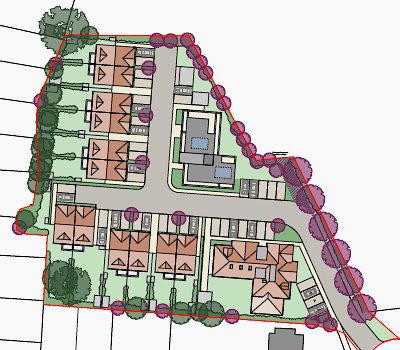 The decision to refuse wider easement access over the commons for the Merrywood development has been overturned by the Council.
The decision to refuse wider easement access over the commons for the Merrywood development has been overturned by the Council.
We have received bitterly disappointing news from Elmbridge Borough Council that Cabinet has voted in favour of varying the easement across the common land, which will allow the access to Merrywood to be widened, thus accommodating the development of the site.
Residents will probably be familiar with the background (click here to see article).
Although former Councillor Tannia Shipley and Councillor Nigel Haig-Brown (both Hinchley Wood and Weston Green ward) fought hard in the Planning Committee to have the Merrywood development proposal turned down (on the basis of cramped housing and poor design), a majority (Conservative and Lib Dem Councillors) voted to allow it.
However the existing easement giving access to Merrywood across common land was not wide enough, so the developer applied for a grant of easement to widen the access. This was refused in an Individual Cabinet Members Decision Making meeting. That decision was 'called in' on 30th March by several Conservative and Lib Dem Councillors, and it was referred to the Overview & Scrutiny Committee (Overview & Scrutiny is an important aspect of local government - chaired by the party in opposition, providing checks and balances on Council decisions). O&S supported the 'calling in' process and recommended that the matter of the easement be re-considered by the full Cabinet. This was ratified by full Council in July, so the matter was brought before Cabinet on 15th September. We have two local Councillors in Cabinet - Karen Randolph (TD & WG RA) and Janet Turner (Hinchley Wood RA) who both put forward the case that common land is sacrosanct and the easement should not be granted; but they were two lone voices and the resolution to approve the variation to the existing easement was passed by a show of hands.
The Residents' Association and our ward councillors have fought long and hard, and supported local residents, against overdevelopment of this site. None of us would argue against putting it to residential use, but a combination of national policies and local housing need have created a presumption in favour of development that in this case has overridden issues of housing quality. However, we will continue to fight for the appropriate standards in all residential developments.
So, what happens next? The variation to the existing easement must be approved by the Secretary of State. This will be subject to satisfactory negotiation of the terms, which has been delegated to the Council’s Strategic Director and Deputy Chief Executive, along with the Portfolio Holder for Resources. We understand there is one more slim chance to make our voices heard, which is when the matter is finally referred to the Secretary of State for sign off. At that stage it is possible to write to the planning inspectorate giving reasons why the widening of the access across common land is unacceptable. It stands little chance of success, but it is worth exploring every channel open to us.
